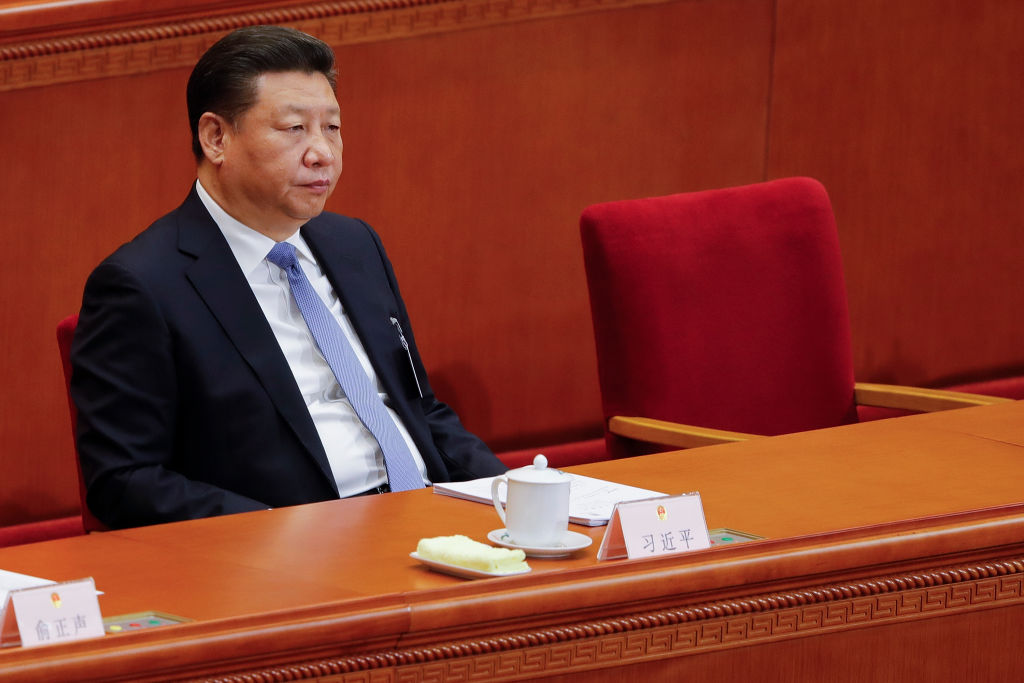
As the Chinese Communist Party convenes next week to embellish and extend Xi Jinping’s role as emperor, the mandate of heaven wobbles.
The imperial mandate has been translated into a Marxist mandate of history. Heaven or history, the mandate confers legitimacy based on performance.
One CCP gauge for the state of the mandate is ‘comprehensive national power’, measuring a country’s economic, military and political weight. The national power calculation draws on the Soviet concept of the correlation of world forces and Karl Marx’s observation: ‘Merely quantitative differences, beyond a certain point, pass into qualitative changes.’
For much of Xi’s decade, the quantities have stacked up favourably and the quality of China’s power surged. The comprehensive power needle leant China’s way, pointing to significant gains against other states.
Suddenly, though, the power needle has stuttered. At the very least, the relative growth of Chinese power has slowed. And whisper it quietly as the emperor steps higher: some slippage is apparent.
The tide turns against China’s helmsman, domestically and internationally.
One bad period doesn’t negate all China has achieved since Xi took office in 2012, yet the power meter blips. This is not the 2022 that Xi ordered—a masterfully staged Beijing Olympics was supposed to be followed by a calm, ordered progress to the 20th National Party Congress.
The CCP gathers to bury the collective leadership model and remove all checks on Xi as China staggers on through Covid-19 lockdowns. Consider the irony, Kerry Brown comments, if a public health issue caused the people to question Xi’s mandate: ‘Zero-Covid is having an impact across the nation. A government that places ideology and political commitment above everything—even the public wellbeing and economic prosperity that lies at the heart of their legitimacy—runs risks like never before.’
Runs risks? That’s far from the calmly confident congress Xi wants.
Beijing set a GDP target of 5.5% for this year, but is on course for its biggest ever GDP miss. The actual percentage figure to be delivered will start with a 4 or even a 3. The days of double-digit growth fade to history. The middle-income trap is snapping. The debt mountain has become what Reuters calls ‘a threat to China’s stability and even the world’s economic health’. The real estate crash is ‘a slow motion financial crisis’, revealing systemic problems. The demographic reckoning looms as China’s population ages faster than that of any other country in modern history.
China exults that it’s the world’s largest exporter and official creditor, but frets at the might of the US dollar, still the most important currency, pre-eminent in trade and cross-border debt.
Unable to knock the greenback from its peak, Beijing seeks to build a digital payments system instead. The digital currency is ‘programable’, allowing China to impose conditions, giving a ‘god’s eye view of the currency’ and how it’s used. See ASPI’s 2020 report on the international implications of the digital version of the yuan.
Putting much of this together, Sebastian Mallaby has penned an op-ed pointing to the emerging cracks in the system, starting with these opposed questions: ‘Is China (a) an economic juggernaut, rapidly overtaking the United States in the technologies of tomorrow? Or is it (b) an ailing giant, doomed by demography, failing real estate developers and counterproductive government diktat?’
The CCP will embrace option (a) because Xi—princeling turned emperor—is both product and expression of the party.
China’s strategic equation has shifted dramatically since 4 February, when Xi and Russia’s Vladimir Putin announced their ‘no limits’ pact, pledging ‘no “forbidden” areas of cooperation’. Ukraine has turned this into a limited liability deal, with much off limits.
China stays on the safe side of the sanctions against Russia, offering supporting words but no weapons. When the two leaders met again last month, Putin acknowledged Xi’s ‘questions and concerns’. Whatever the cracks in the marriage of convenience, Xi is bound to his fellow autocrat in a dangerous world.
Beijing’s judgement of the military balance suddenly involves a huge Russia discount. On the other side of the calculation sits the new 50-nation Ukraine Defense Contact Group, offering what the US describes as momentum and resolve.
China’s military budget has grown for 27 consecutive years and it’s comfortably settled as the world’s second largest, while still well short of half what the US spends. Broaden beyond the bilateral comparison, though, and the power computation becomes problematic.
China’s growing assertiveness is a major driver of military spending by countries such as Australia and Japan (the 7.3% jump in Japan’s defence budget last year was the biggest annual increase in 50 years).
The total defence spending of the Quad (Australia, India, Japan and the US) is triple that of China. No question about the prime driver for the Quad getting back together in 2017: a disruptive Xi is the group’s godfather.
The self-obsession of the CCP means it pays close attention to parties and political players elsewhere. Beijing will have noted the alliance of parliamentarians from almost 30 countries drawing up a blueprint last month to help democracies resist Chinese intimidation. The Inter-Parliamentary Alliance on China aims to safeguard the international rules-based order, uphold human rights, promote trade fairness, strengthen security and protect national integrity.
From values to vital defence kit, there’s a lot of pushback happening.
No clear answer is possible in the debate about whether we’re approaching ‘peak China’. Indeed, a slowing or weakening China might be more dangerous than a nation confident that time is on its side.
The spectre haunting the CCP congress is that the international tide has turned, while the domestic waters are choppy.
The clear judgement is that the relative increase in China’s power is slowing.
The needle on the power meter is wavering, and it might just be waning.

